| Home · All Classes · Modules |
The QRect class defines a rectangle in the plane using integer precision. More...
This class can be pickled.
The QRect class defines a rectangle in the plane using integer precision.
A rectangle is normally expressed as an upper-left corner and a size. The size (width and height) of a QRect is always equivalent to the mathematical rectangle that forms the basis for its rendering.
A QRect can be constructed with a set of left, top, width and height integers, or from a QPoint and a QSize. The following code creates two identical rectangles.
QRect r1(100, 200, 11, 16); QRect r2(QPoint(100, 200), QSize(11, 16));
There is a third constructor that creates a QRect using the top-left and bottom-right coordinates, but we recommend that you avoid using it. The rationale is that for historical reasons the values returned by the bottom() and right() functions deviate from the true bottom-right corner of the rectangle.
The QRect class provides a collection of functions that return the various rectangle coordinates, and enable manipulation of these. QRect also provide functions to move the rectangle relative to the various coordinates. In addition there is a moveTo() function that moves the rectangle, leaving its top left corner at the given coordinates. Alternatively, the translate() function moves the rectangle the given offset relative to the current position, and the translated() function returns a translated copy of this rectangle.
The size() function returns the rectange's dimensions as a QSize. The dimensions can also be retrieved separately using the width() and height() functions. To manipulate the dimensions use the setSize(), setWidth() or setHeight() functions. Alternatively, the size can be changed by applying either of the functions setting the rectangle coordinates, for example, setBottom() or setRight().
The contains() function tells whether a given point is inside the rectangle or not, and the intersects() function returns true if this rectangle intersects with a given rectangle. The QRect class also provides the intersected() function which returns the intersection rectangle, and the united() function which returns the rectangle that encloses the given rectangle and this:
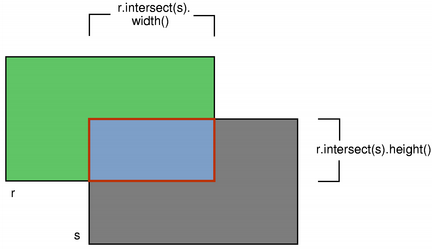 |
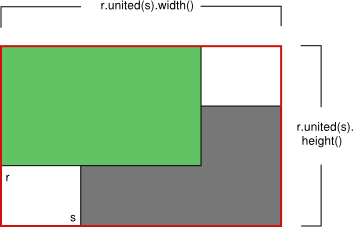 |
| intersected() | united() |
The isEmpty() function returns true if left() > right() or top() > bottom(). Note that an empty rectangle is not valid: The isValid() function returns true if left() <= right() and top() <= bottom(). A null rectangle (isNull() == true) on the other hand, has both width and height set to 0.
Note that due to the way QRect and QRectF are defined, an empty QRect is defined in essentially the same way as QRectF.
Finally, QRect objects can be streamed as well as compared.
When using an anti-aliased painter, the boundary line of a QRect will be rendered symmetrically on both sides of the mathematical rectangle's boundary line. But when using an aliased painter (the default) other rules apply.
Then, when rendering with a one pixel wide pen the QRect's boundary line will be rendered to the right and below the mathematical rectangle's boundary line.
When rendering with a two pixels wide pen the boundary line will be split in the middle by the mathematical rectangle. This will be the case whenever the pen is set to an even number of pixels, while rendering with a pen with an odd number of pixels, the spare pixel will be rendered to the right and below the mathematical rectangle as in the one pixel case.
 |
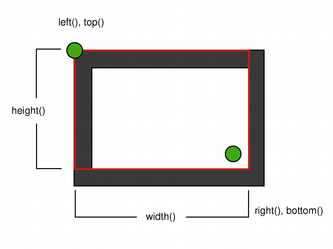 |
| Logical representation | One pixel wide pen |
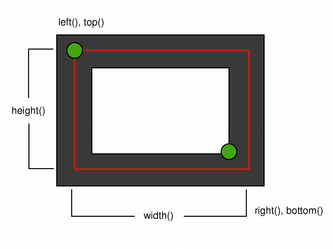 |
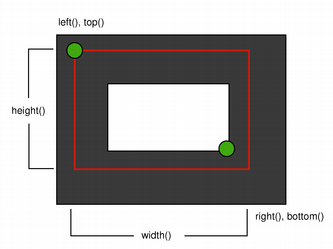 |
| Two pixel wide pen | Three pixel wide pen |
The QRect class provides a collection of functions that return the various rectangle coordinates, and enable manipulation of these. QRect also provide functions to move the rectangle relative to the various coordinates.
For example the left(), setLeft() and moveLeft() functions as an example: left() returns the x-coordinate of the rectangle's left edge, setLeft() sets the left edge of the rectangle to the given x coordinate (it may change the width, but will never change the rectangle's right edge) and moveLeft() moves the entire rectangle horizontally, leaving the rectangle's left edge at the given x coordinate and its size unchanged.

Note that for historical reasons the values returned by the bottom() and right() functions deviate from the true bottom-right corner of the rectangle: The right() function returns left() + width() - 1 and the bottom() function returns top() + height() - 1. The same is the case for the point returned by the bottomRight() convenience function. In addition, the x and y coordinate of the topRight() and bottomLeft() functions, respectively, contain the same deviation from the true right and bottom edges.
We recommend that you use x() + width() and y() + height() to find the true bottom-right corner, and avoid right() and bottom(). Another solution is to use QRectF: The QRectF class defines a rectangle in the plane using floating point accuracy for coordinates, and the QRectF.right() and QRectF.bottom() functions do return the right and bottom coordinates.
It is also possible to add offsets to this rectangle's coordinates using the adjust() function, as well as retrieve a new rectangle based on adjustments of the original one using the adjusted() function. If either of the width and height is negative, use the normalized() function to retrieve a rectangle where the corners are swapped.
In addition, QRect provides the getCoords() function which extracts the position of the rectangle's top-left and bottom-right corner, and the getRect() function which extracts the rectangle's top-left corner, width and height. Use the setCoords() and setRect() function to manipulate the rectangle's coordinates and dimensions in one go.
Constructs a null rectangle.
See also isNull().
Constructs a rectangle with the given topLeft and bottomRight corners.
See also setTopLeft() and setBottomRight().
Constructs a rectangle with the given topLeft corner and the given size.
See also setTopLeft() and setSize().
Constructs a rectangle with (x, y) as its top-left corner and the given width and height.
See also setRect().
Adds dx1, dy1, dx2 and dy2 respectively to the existing coordinates of the rectangle.
See also adjusted() and setRect().
Returns a new rectangle with dx1, dy1, dx2 and dy2 added respectively to the existing coordinates of this rectangle.
See also adjust().
Returns the y-coordinate of the rectangle's bottom edge.
Note that for historical reasons this function returns top() + height() - 1; use y() + height() to retrieve the true y-coordinate.
See also setBottom(), bottomLeft(), and bottomRight().
Returns the position of the rectangle's bottom-left corner. Note that for historical reasons this function returns QPoint(left(), top() + height() - 1).
See also setBottomLeft(), bottom(), and left().
Returns the position of the rectangle's bottom-right corner.
Note that for historical reasons this function returns QPoint(left() + width() -1, top() + height() - 1).
See also setBottomRight(), bottom(), and right().
Returns the center point of the rectangle.
See also moveCenter().
Returns true if the given point is inside or on the edge of the rectangle, otherwise returns false. If proper is true, this function only returns true if the given point is inside the rectangle (i.e., not on the edge).
See also intersects().
This is an overloaded function.
Returns true if the point (x, y) is inside or on the edge of the rectangle, otherwise returns false. If proper is true, this function only returns true if the point is entirely inside the rectangle(not on the edge).
This is an overloaded function.
Returns true if the point (x, y) is inside this rectangle, otherwise returns false.
This is an overloaded function.
Returns true if the given rectangle is inside this rectangle. otherwise returns false. If proper is true, this function only returns true if the rectangle is entirely inside this rectangle (not on the edge).
Extracts the position of the rectangle's top-left corner to *x1 and *y1, and the position of the bottom-right corner to *x2 and *y2.
See also setCoords() and getRect().
Extracts the position of the rectangle's top-left corner to *x and *y, and its dimensions to *width and *height.
See also setRect() and getCoords().
Returns the height of the rectangle.
See also setHeight(), width(), and size().
Returns the intersection of this rectangle and the given rectangle. Note that r.intersected(s) is equivalent to r & s.

This function was introduced in Qt 4.2.
See also intersects(), united(), and operator&=().
Returns true if this rectangle intersects with the given rectangle (i.e., there is at least one pixel that is within both rectangles), otherwise returns false.
The intersection rectangle can be retrieved using the intersected() function.
See also contains().
Returns true if the rectangle is empty, otherwise returns false.
An empty rectangle has a left() > right() or top() > bottom(). An empty rectangle is not valid (i.e., isEmpty() == !isValid()).
Use the normalized() function to retrieve a rectangle where the corners are swapped.
See also isNull(), isValid(), and normalized().
Returns true if the rectangle is a null rectangle, otherwise returns false.
A null rectangle has both the width and the height set to 0 (i.e., right() == left() - 1 and bottom() == top() - 1). A null rectangle is also empty, and hence is not valid.
See also isEmpty() and isValid().
Returns true if the rectangle is valid, otherwise returns false.
A valid rectangle has a left() < right() and top() < bottom(). Note that non-trivial operations like intersections are not defined for invalid rectangles. A valid rectangle is not empty (i.e., isValid() == !isEmpty()).
See also isNull(), isEmpty(), and normalized().
Returns the x-coordinate of the rectangle's left edge. Equivalent to x().
See also setLeft(), topLeft(), and bottomLeft().
Moves the rectangle vertically, leaving the rectangle's bottom edge at the given y coordinate. The rectangle's size is unchanged.
See also bottom(), setBottom(), and moveTop().
Moves the rectangle, leaving the bottom-left corner at the given position. The rectangle's size is unchanged.
See also setBottomLeft(), moveBottom(), and moveLeft().
Moves the rectangle, leaving the bottom-right corner at the given position. The rectangle's size is unchanged.
See also setBottomRight(), moveRight(), and moveBottom().
Moves the rectangle, leaving the center point at the given position. The rectangle's size is unchanged.
See also center().
Moves the rectangle horizontally, leaving the rectangle's left edge at the given x coordinate. The rectangle's size is unchanged.
See also left(), setLeft(), and moveRight().
Moves the rectangle horizontally, leaving the rectangle's right edge at the given x coordinate. The rectangle's size is unchanged.
See also right(), setRight(), and moveLeft().
Moves the rectangle, leaving the top-left corner at the given position (x, y). The rectangle's size is unchanged.
See also translate() and moveTopLeft().
Moves the rectangle, leaving the top-left corner at the given position.
Moves the rectangle vertically, leaving the rectangle's top edge at the given y coordinate. The rectangle's size is unchanged.
See also top(), setTop(), and moveBottom().
Moves the rectangle, leaving the top-left corner at the given position. The rectangle's size is unchanged.
See also setTopLeft(), moveTop(), and moveLeft().
Moves the rectangle, leaving the top-right corner at the given position. The rectangle's size is unchanged.
See also setTopRight(), moveTop(), and moveRight().
Returns a normalized rectangle; i.e., a rectangle that has a non-negative width and height.
If width() < 0 the function swaps the left and right corners, and it swaps the top and bottom corners if height() < 0.
See also isValid() and isEmpty().
Returns the x-coordinate of the rectangle's right edge.
Note that for historical reasons this function returns left() + width() - 1; use x() + width() to retrieve the true x-coordinate.
See also setRight(), topRight(), and bottomRight().
Sets the bottom edge of the rectangle to the given y coordinate. May change the height, but will never change the top edge of the rectangle.
See also bottom() and moveBottom().
Set the bottom-left corner of the rectangle to the given position. May change the size, but will never change the top-right corner of the rectangle.
See also bottomLeft() and moveBottomLeft().
Set the bottom-right corner of the rectangle to the given position. May change the size, but will never change the top-left corner of the rectangle.
See also bottomRight() and moveBottomRight().
Sets the coordinates of the rectangle's top-left corner to (x1, y1), and the coordinates of its bottom-right corner to (x2, y2).
See also coords(), getCoords(), and setRect().
Sets the height of the rectangle to the given height. The bottom edge is changed, but not the top one.
See also height() and setSize().
Sets the left edge of the rectangle to the given x coordinate. May change the width, but will never change the right edge of the rectangle.
Equivalent to setX().
See also left() and moveLeft().
Sets the coordinates of the rectangle's top-left corner to (x, y), and its size to the given width and height.
See also rect(), getRect(), and setCoords().
Sets the right edge of the rectangle to the given x coordinate. May change the width, but will never change the left edge of the rectangle.
See also right() and moveRight().
Sets the size of the rectangle to the given size. The top-left corner is not moved.
See also size(), setWidth(), and setHeight().
Sets the top edge of the rectangle to the given y coordinate. May change the height, but will never change the bottom edge of the rectangle.
Equivalent to setY().
Set the top-left corner of the rectangle to the given position. May change the size, but will never change the bottom-right corner of the rectangle.
See also topLeft() and moveTopLeft().
Set the top-right corner of the rectangle to the given position. May change the size, but will never change the bottom-left corner of the rectangle.
See also topRight() and moveTopRight().
Sets the width of the rectangle to the given width. The right edge is changed, but not the left one.
See also width() and setSize().
Sets the left edge of the rectangle to the given x coordinate. May change the width, but will never change the right edge of the rectangle.
Equivalent to setLeft().
See also x(), setY(), and setTopLeft().
Sets the top edge of the rectangle to the given y coordinate. May change the height, but will never change the bottom edge of the rectangle.
Equivalent to setTop().
See also y(), setX(), and setTopLeft().
Returns the size of the rectangle.
See also setSize(), width(), and height().
Returns the y-coordinate of the rectangle's top edge. Equivalent to y().
See also setTop(), topLeft(), and topRight().
Returns the position of the rectangle's top-left corner.
See also setTopLeft(), top(), and left().
Returns the position of the rectangle's top-right corner.
Note that for historical reasons this function returns QPoint(left() + width() -1, top()).
See also setTopRight(), top(), and right().
Moves the rectangle dx along the x axis and dy along the y axis, relative to the current position. Positive values move the rectangle to the right and down.
See also moveTopLeft(), moveTo(), and translated().
This is an overloaded function.
Moves the rectangle offset.x() along the x axis and offset.y() along the y axis, relative to the current position.
Returns a copy of the rectangle that is translated dx along the x axis and dy along the y axis, relative to the current position. Positive values move the rectangle to the right and down.
See also translate().
This is an overloaded function.
Returns a copy of the rectangle that is translated offset.x() along the x axis and offset.y() along the y axis, relative to the current position.
Returns the bounding rectangle of this rectangle and the given rectangle.

This function was introduced in Qt 4.2.
See also intersected().
Returns the width of the rectangle.
See also setWidth(), height(), and size().
Returns the x-coordinate of the rectangle's left edge. Equivalent to left().
See also setX(), y(), and topLeft().
Returns the y-coordinate of the rectangle's top edge. Equivalent to top().
See also setY(), x(), and topLeft().
| PyQt 4.11.4 for X11 | Copyright © Riverbank Computing Ltd and The Qt Company 2015 | Qt 4.8.7 |